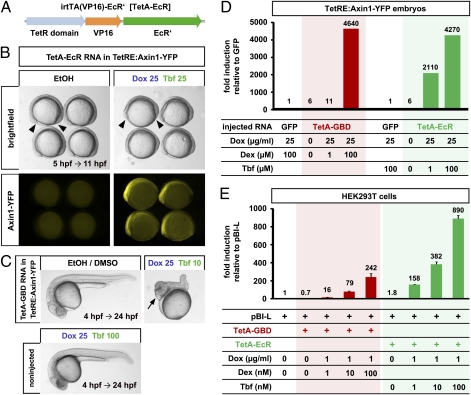Fig. 4.
An ecdysone receptor-based dually inducible TetActivator. (A) TetA-EcR construct. (B) Induction of Axin1-YFP in TetRE:Axin1-YFP transgenic embryos injected with 100 pg of TetA-EcR RNA, treated with 25 μg/mL Dox and 25 μM Tebufenozide (Tbf) from 5 hpf and photographed at 11 hpf. Note shortened body axes (arrowheads) indicative of Axin1 gain-of-function phenotypes in drug-treated embryos. n = 10/group. (C) Severe Axin1 overexpression phenotype (posterior truncations and expanded anterior fates; arrow) in 25 μg/mL Dox and 10 μM Tbf drug-treated embryos at 24 hpf. Note that embryos treated with EtOH/DMSO vehicle and noninjected embryos treated with even higher doses of Dox/Tbf develop normally. n = 32 noninj, 6 EtOH/DMSO, 6 Dox/Tbf. (D) TetA-EcR induces more strongly than TetA-GBD at low drug doses in zebrafish. TetRE:Axin1-YFP embryos were injected with equimolar amounts of GFP (25 pg), TetA-GBD (50 pg) or TetA-EcR (55 pg) RNA, treated with the indicated drugs at 5 hpf for 3 h, YFP expression was quantified using QPCR and is shown relative to GFP controls treated with the same drugs. Zero indicates EtOH vehicle only. (E) TetA-EcR is more efficient than TetA-GBD in mammalian cells. HEK293 cells were transiently transfected with the Tet responsive luciferase reporter pBI-L and the activators TetA-GBD or TetA-EcR, and luciferase levels were measured after treatment with indicated doses of drugs. Levels are shown relative to cells transfected with pBI-L only. Error bars represent SEM.

